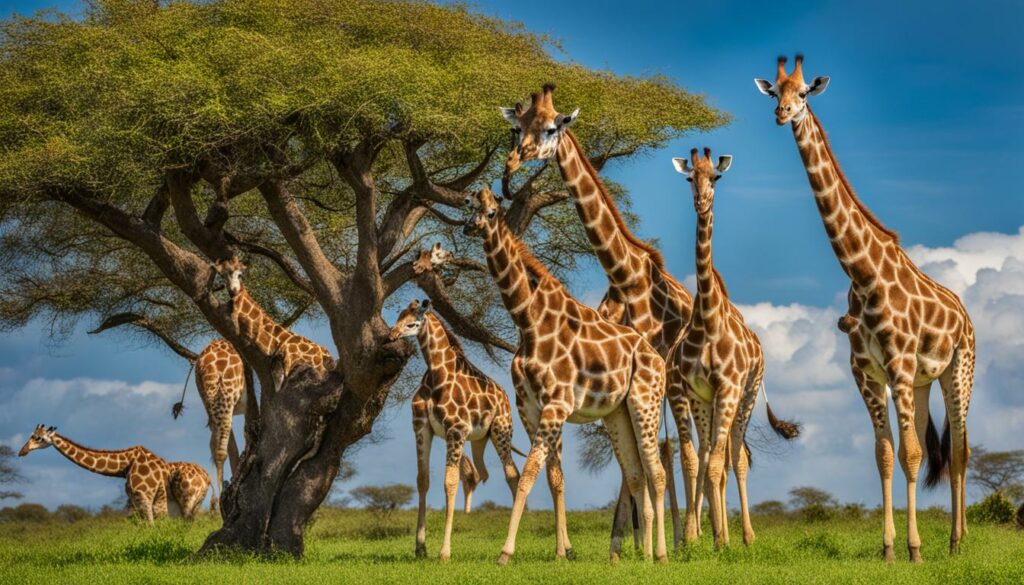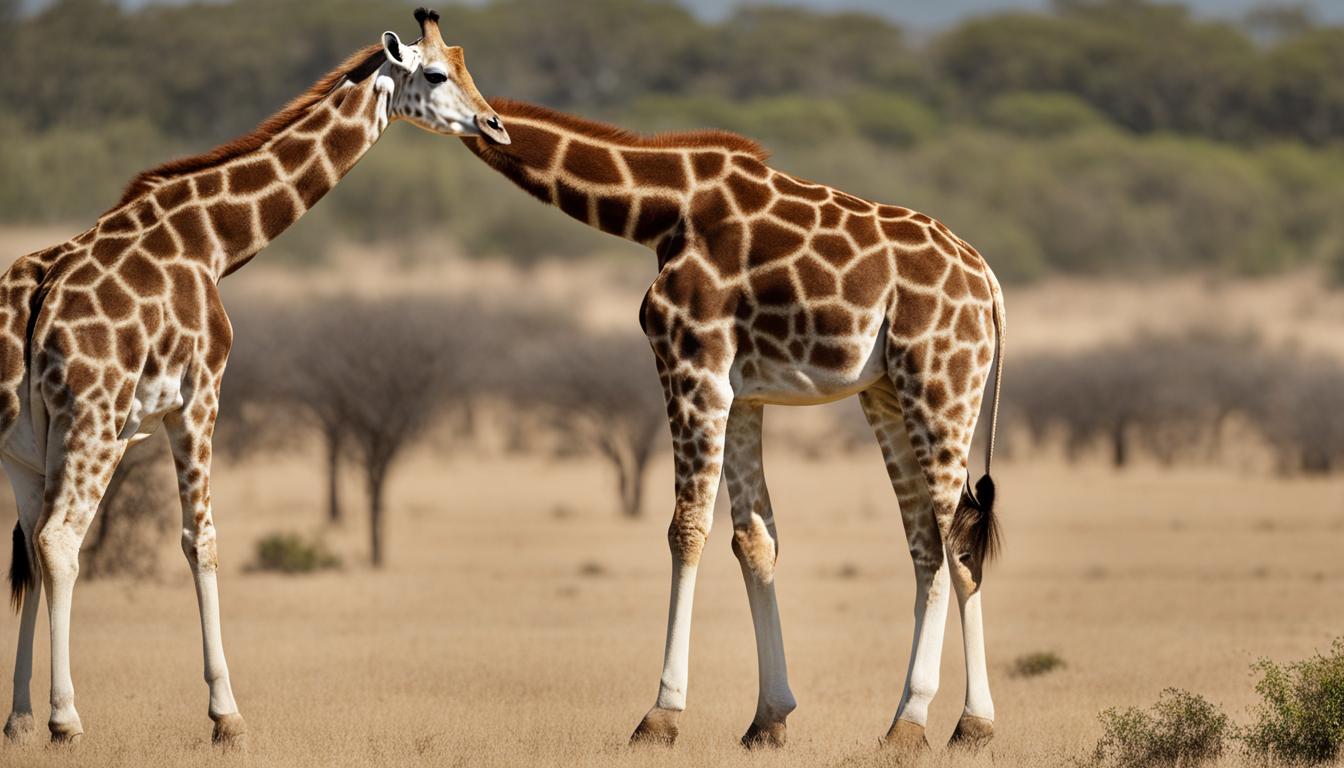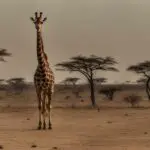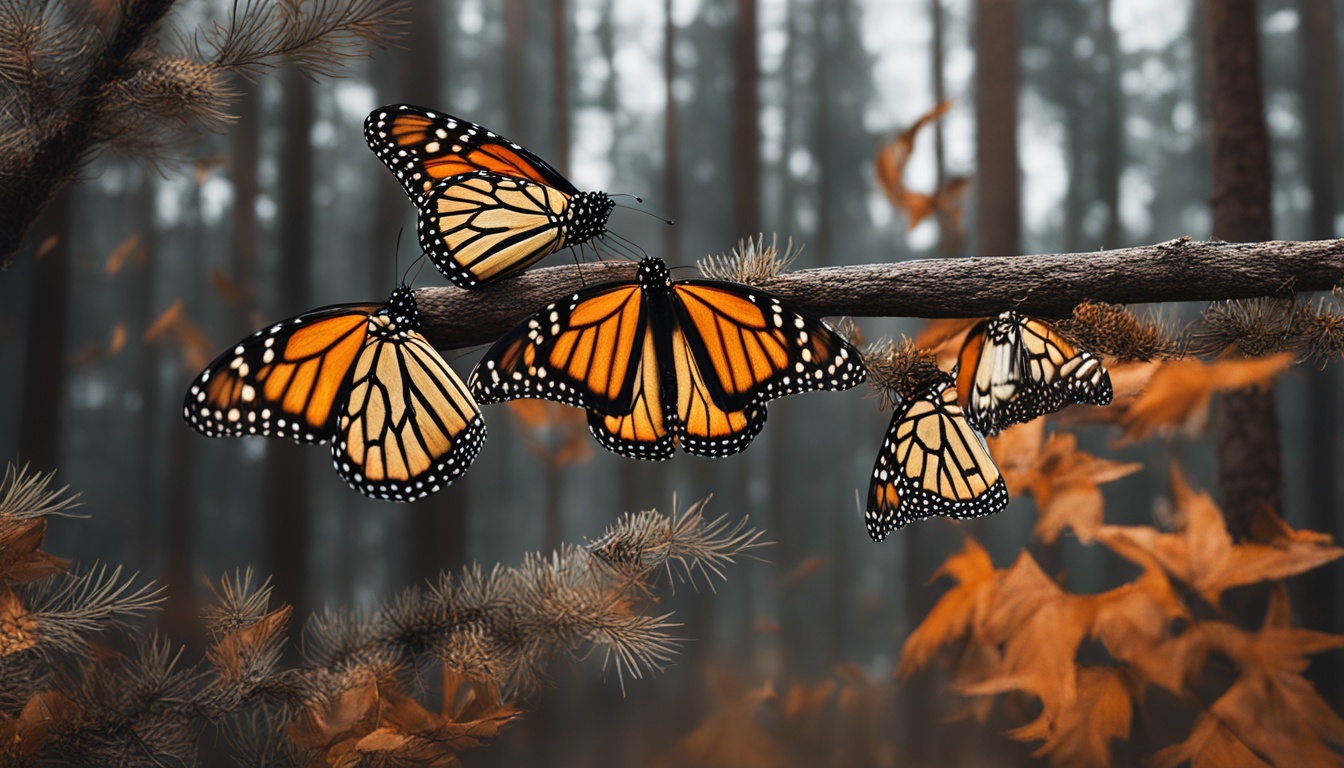Are you curious about the majestic giraffe? Look no further! In this article, we will explore some fascinating and unique facts about these incredible creatures. From their astounding height to their incredible adaptations, there’s so much to discover about giraffes.
Did you know that giraffes hold the title for being the tallest land mammal on the planet? Adult males can reach heights of up to 5.5 meters, allowing them to tower above the African savannah. But that’s not all! Giraffes also come in different species, including the Northern giraffe, Southern giraffe, Reticulated giraffe, and Masai giraffe.
One of the most remarkable features of giraffes is their long necks. But did you know that their tongues are also extraordinary? They are bluish-purple in color and can reach lengths of up to 50 cm! These unique characteristics make giraffes truly amazing creatures.
However, life isn’t always easy for giraffes. In some populations, more than half of the giraffe calves do not survive their first year. This makes every giraffe’s journey even more awe-inspiring.
Now that you have a taste of some interesting giraffe facts, are you ready to dive deeper into their anatomy, behavior, diet, habitat, and more? Stay tuned for the upcoming sections where we’ll explore all these aspects and uncover even more fascinating information about giraffes!
Giraffe Anatomy and Adaptations
Giraffes possess unique physical features and adaptations that allow them to thrive in their environment. These remarkable creatures have long been a subject of fascination, and studying their anatomy sheds light on their incredible adaptations. Let’s explore the anatomy and adaptations of giraffes in more detail.
Anatomy of Giraffes
Giraffes have a distinctive appearance, characterized by their long necks, slender legs, and large, expressive eyes. Their necks, which can measure up to 2 meters in length, consist of seven cervical vertebrae – the same number as humans. However, each of their vertebrae can be up to 25 centimeters long, providing the flexibility and strength necessary to support their massive heads.
Another intriguing feature of giraffes is their unique tongue. It is long, muscular, and bluish-purple in color. With a length of up to 50 centimeters, giraffes use their tongues to grasp and strip leaves from branches. This adaptation allows them to reach foliage that is out of reach for most other herbivores.
Adaptations for Survival
Giraffes have developed several key adaptations that enable them to survive in their habitat. One notable adaptation is their long legs and sturdy hooves. Their feet, about the size of a dinner plate, not only support their massive bodies but also provide stability and agility when moving across uneven terrain. This allows giraffes to navigate the savannah with ease and avoid potential predators.
To overcome the challenge of drinking water, giraffes have developed a unique adaptation in their circulatory system. When they lower their heads to drink, special valves and elastic walls in their jugular veins prevent blood from rushing to their brains and causing a loss of consciousness. This adaptation ensures that giraffes can safely lower their heads without compromising their blood flow.
In addition, giraffes have thick, tight skin on their legs that helps to regulate blood pressure and prevent blood pooling. This adaptation helps them withstand the gravitational pressure caused by their height and maintain proper circulation, even when standing for extended periods. These remarkable adaptations have even captured the attention of NASA, who has studied them for potential applications in human spacesuits.
Giraffe Anatomy and Adaptations – Table
| Physical Feature | Adaptation |
|---|---|
| Long Neck | Allows giraffes to reach high foliage |
| Large Tongue | Enables giraffes to grasp leaves and strip them from branches |
| Long Legs and Hooves | Provide stability and agility on uneven terrain |
| Jugular Vein Adaptation | Prevents blood pooling when giraffes lower their heads to drink |
| Thick, Tight Skin on Legs | Regulates blood pressure and prevents blood pooling |
In conclusion, the anatomy of giraffes is a remarkable example of adaptation to their environment. From their long necks and tongues to their sturdy hooves and unique circulatory system, every aspect of a giraffe’s anatomy serves a purpose in its survival. These adaptations not only enhance their capabilities but also offer insights into our understanding of the natural world.
Giraffe Behavior and Social Structure
Giraffes are known for their unique behavior and fascinating social structure. Let’s dive into some interesting facts about how these majestic creatures behave and interact with one another.
Giraffe Social Structure
Giraffes live in groups called towers, which typically consist of around 15 members led by an adult male known as a bull. The bull is responsible for leading and protecting the tower, using its height and strength to ward off potential threats. Tower members communicate through various vocalizations and body language, maintaining a cohesive social bond.
Giraffe Groups
Giraffes are peaceful animals and rarely engage in aggressive behaviors. However, males sometimes exhibit a behavior known as “necking,” where they swing their long necks and hit each other. This behavior, although seemingly aggressive, is mostly a display of dominance and is rarely escalated into an actual fight. Giraffes also have one of the shortest sleep requirements of any mammal, only needing between 10 minutes and 2 hours of sleep per day. They sleep and give birth standing up, and newborn giraffes can stand within 30 minutes of birth.
Overall, giraffe behavior and social structure showcase their gentle nature and unique ways of communication within their towers. Now, let’s take a deeper look into the diet and feeding habits of these magnificent creatures.

| Behavior | Explanation |
|---|---|
| Social Structure | Giraffes live in groups called towers, led by an adult male. |
| Communication | Giraffes communicate through vocalizations and body language. |
| Necking | Males sometimes swing their necks to display dominance. |
| Sleeping Habits | Giraffes sleep and give birth standing up, requiring minimal sleep. |
Giraffe Diet and Feeding Habits
Giraffes have a unique diet that consists primarily of plants. Their favorite food is the leaves and buds of acacia trees, which they can reach with their long necks and tongues. These adaptations allow them to feed on vegetation that other animals cannot access. In addition to acacia leaves, giraffes also consume various grasses, fruits, and seeds.
Giraffes are herbivores and have a voracious appetite. On average, they can consume up to 45 kilograms of leaves and twigs per day. Their long necks and specialized digestive systems allow them to efficiently extract nutrients from their food. Unlike ruminants, giraffes have a single-chambered stomach. Instead of fermenting food for an extended period, they rely on bacteria and microorganisms present in their gastrointestinal tract to aid digestion.
Despite their ability to eat large quantities of vegetation, giraffes do not need to drink water frequently. They obtain most of their hydration from the leaves and buds they consume, and they can go several days without drinking. When they do drink, they have to splay their forelegs and bend their knees to reach the water source due to their long necks. This behavior is a testament to their incredible adaptability and resourcefulness in their natural habitat.
| Food | Percentage of Diet |
|---|---|
| Acacia Leaves | 55% |
| Grasses | 25% |
| Fruits | 10% |
| Seeds | 5% |
| Other Vegetation | 5% |
Giraffe Habitat and Distribution
Giraffes are well-adapted to their unique habitat in the dry savannahs of Africa. They are commonly found roaming among open plains and woodlands, where their tall stature and excellent eyesight give them an advantage in spotting predators like lions and hyenas from a distance. This enables them to avoid potential threats and stay safe in their environment. Giraffes can endure long periods without water, as they obtain most of their hydration from the leaves they consume.
As for their distribution, giraffes are currently found in various countries across Africa. However, it is unfortunate to note that they are extinct in at least seven countries. The exact number of giraffes in the wild is difficult to determine due to the vastness of their habitat and the challenges of tracking their populations. Conservation efforts are crucial to protect these magnificent creatures and ensure their survival in the wild.
Giraffe Habitat and Distribution
| Country | Population | Status |
|---|---|---|
| Kenya | Approximately 28,850 | Stable |
| Tanzania | Approximately 36,000 | Decreasing |
| South Africa | Approximately 20,000 | Increasing |
| Botswana | Approximately 25,000 | Stable |
These numbers represent estimates and may vary due to ongoing research and changes in population dynamics. It is essential to continue monitoring giraffe populations and implementing conservation strategies to protect their habitat and ensure their long-term survival.
Conclusion
Giraffes are truly remarkable creatures with their towering height, unique adaptations, and fascinating behaviors. Their long necks, distinctive coat patterns, and social structure make them a sight to behold in the wild. With their incredible adaptations for drinking and blood flow, giraffes have even captivated the attention of scientists at NASA.
Throughout this article, you’ve learned about the interesting facts, anatomy, behavior, diet, habitat, and distribution of giraffes. These incredible animals are the tallest land mammals, with adult males reaching heights of up to 5.5 meters. Giraffes have a variety of adaptations that allow them to thrive in their environments, from their splayed forelegs for drinking to their specialized blood vessels and skin to fight gravity. They are also social animals, living in groups called towers and rarely engaging in aggressive behavior.
As herbivores, giraffes primarily eat plants, with their favorite food being the leaves and buds of acacia trees. Their long necks and tongues enable them to reach high up into the trees for their meals. Giraffes are found in the dry savannahs of Africa, where they can spot predators from a distance due to their excellent eyesight.
Understanding giraffes and their unique characteristics helps us appreciate the diversity and beauty of the natural world. From their incredible height to their adaptations for survival, these amazing creatures have captured the imagination of both scientists and nature enthusiasts alike. So next time you see a giraffe, take a moment to marvel at its magnificence and the wonders of the animal kingdom.
Do Giraffes Exhibit Different Behaviors in the Wild Versus in Captivity?
Giraffe behavior in the wild and captivity can vary significantly. In the wild, giraffes exhibit natural behaviors such as socializing in herds, feeding from tall trees, and engaging in territorial fights. In captivity, however, their behavior may be influenced by limited space, human interaction, and controlled diets. These differences highlight the importance of providing suitable environments for these magnificent creatures.
Do the spots on a giraffe serve any specific purpose or function?
Giraffe spots are not just a beautiful feature – they serve a crucial purpose. These distinct patterns act as camouflage, helping giraffes blend in with their surroundings and making it harder for predators to spot them. Additionally, the spots also help regulate body temperature by dispersing heat throughout their long necks. Giraffe spots and their purpose contribute to their survival in the African savannah.
FAQ
What is the tallest land mammal?
The tallest land mammal is the giraffe, with adult males reaching heights of up to 5.5 meters.
How many species of giraffes are there?
There are four distinct species of giraffe: Northern giraffe, Southern giraffe, Reticulated giraffe, and Masai giraffe.
What color is a giraffe’s tongue?
A giraffe’s tongue is bluish-purple in color.
How long can a giraffe’s tongue grow?
A giraffe’s tongue can reach lengths of up to 50 cm.
What percentage of giraffe calves do not survive their first year?
In some populations, over 50% of giraffe calves do not survive their first year.
How do giraffes drink water?
Giraffes have to splay their forelegs and bend their knees to drink water.
Why do giraffes have to drink in a specific way?
Giraffes have elastic walls and one-way valves in their jugular veins to protect their brains when they lower their heads to drink.
What have giraffe adaptations been studied for?
Giraffe adaptations, such as their blood flow and skin, have been studied by NASA for inspiration in human space suits.
What is a group of giraffes called?
A group of giraffes is called a tower.
How many members are typically in a giraffe tower?
Towers typically have around 15 members led by an adult male.
Do giraffes fight?
Giraffes are peaceful animals and rarely fight, but males sometimes hit their necks against each other in a behavior called “necking.”
How much sleep do giraffes need?
Giraffes only need between 10 minutes and 2 hours of sleep per day.
How long does it take for a newborn giraffe to stand?
Newborn giraffes can stand within 30 minutes of birth.
What do giraffes eat?
Giraffes are herbivores and primarily eat plants.
What is a giraffe’s favorite food?
A giraffe’s favorite food is the leaves and buds of acacia trees.
How much can a giraffe eat in a day?
Giraffes can consume up to 45 kg of leaves and twigs per day.
How often do giraffes need to drink water?
Giraffes only need to drink water once every few days, as they get most of their water from their leafy meals.
Where are giraffes found?
Giraffes are found in the dry savannahs of Africa, where they roam among open plains and woodlands.
Can giraffes spot predators easily?
Yes, giraffes have excellent eyesight and can spot predators, such as lions and hyenas, from a distance.
How many countries in Africa are giraffes extinct in?
Giraffes are currently extinct in at least seven countries in Africa.











